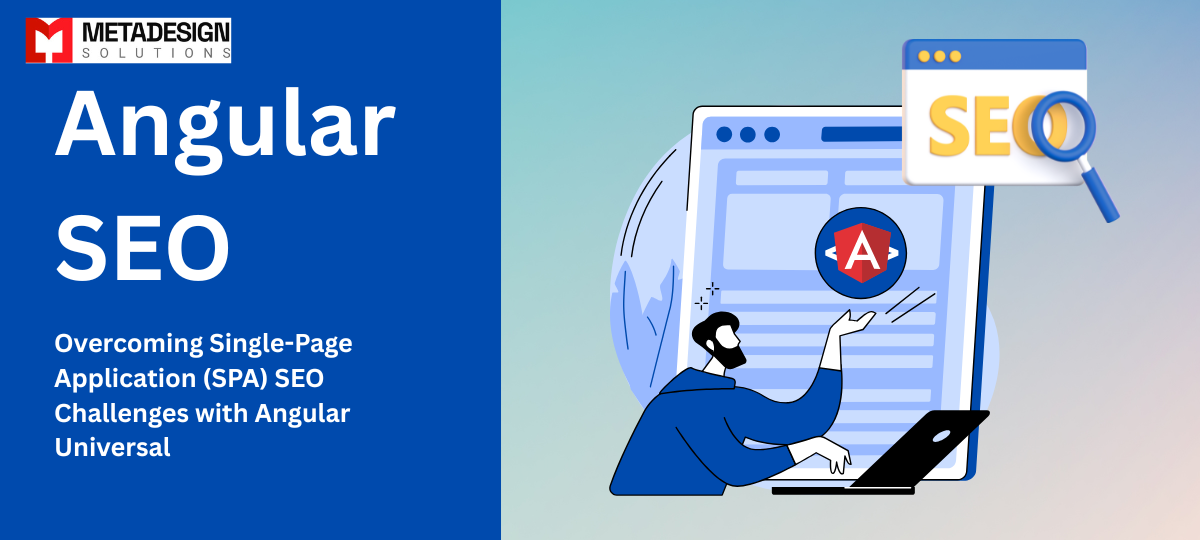I. Introduction: The SPA SEO Problem (The Hook)
The Paradox of Modern Web Development
The rise of the Single-Page Application (SPA) delivered a massive leap forward in user experience (UX). SPAs feel fast, responsive, and desktop-like. But if you manage a large, content-driven application, you’ve likely faced the paradox: The better your UX, the worse your organic search visibility seems to become.
You built a streamlined, lightning-fast application, but search engines like Google still treat it like a ghost ship. Why?
The Core Technical Challenge: Crawler Blindness
Traditional SPAs rely on Client-Side Rendering (CSR). When a search engine crawler—Googlebot—visits your site, it receives only a skeleton index.html file, which contains references to large JavaScript bundles. The actual content is invisible until the crawler executes all that complex JavaScript.
This delay and reliance on heavy processing means that your content may be indexed slowly, incompletely, or sometimes, not at all. You’ve become functionally invisible to a vast segment of your potential audience.
Thesis Statement
The solution to this painful trade-off is not abandoning SPAs; it’s adopting Angular Universal (Server-Side Rendering, or SSR). Universal is the necessary architectural step that allows you to deliver the best of both worlds: superior UX and flawless SEO performance. By fully rendering your application on the server, you serve completely hydrated HTML to both users and crawlers.
In this deep dive, we’ll break down exactly why Universal is the definitive fix, its direct SEO benefits, and the immediate performance gains that will stabilize your Core Web Vitals (FCP, TTI).
II. Deconstructing the SEO Deficiency in Client-Side Rendering (CSR)
How CSR Works (and Fails SEO)
In a CSR application, the typical flow looks like this:
- The browser/crawler requests the page (index.html).
- It receives a virtually empty HTML shell.
- It must then download, parse, and execute a large JavaScript application bundle.
- Only then does the application render content, pull data from APIs, and populate the page.
While Google has gotten better at rendering JavaScript, relying on this process is a massive risk. You are essentially asking a third party (Googlebot) to dedicate compute resources to rendering your application, which leads us to the next challenge.
The Crawl Budget Cost
Search engines operate on a Crawl Budget—the number of pages a bot can and will process on your site during a given period. When Googlebot encounters a heavy JavaScript-dependent page, it spends a significant portion of that budget on rendering the page, rather than discovering new content. This is a severe problem for large sites, leading to slow indexation and poor content visibility, especially for dynamic routes.
The Performance Penalty
SEO ranking today is inextricably linked to Page Experience, measured by Core Web Vitals. CSR inherently struggles with two major metrics:
- First Contentful Paint (FCP): The time until the user sees the first piece of content. In CSR, this is delayed until the large JS bundle downloads and runs.
- Time to Interactive (TTI): The time until the page is fully interactive. This waits for the entire application to bootstrap.
When content is slow to appear, it hurts both your SEO ranking and your user retention.
Unlock the Power of SEO for SPAs with Angular Universal - Start Optimizing Now!
Optimize your SPA’s SEO with Angular Universal and boost your web visibility. Start improving your site’s performance today!
III. The Solution: Server-Side Rendering (SSR) with Angular Universal
Defining Angular Universal
Angular Universal is a powerful technology that enables Server-Side Rendering (SSR) for Angular applications. It’s not a framework change; it’s an application of the Angular platform that runs on a server environment (typically Node.js) to pre-render the application’s initial state.
How Universal Solves the Core Problem (The Flow)
Universal fundamentally alters the rendering flow to serve two different clients efficiently:
- Crawler View: When Googlebot requests a page, the server executes the Angular app, renders the complete HTML (including all content, data, and metadata), and sends that finished HTML to the crawler. The crawler sees a fully populated, static page, satisfying all its SEO requirements immediately.
- User View (Hydration): The user receives the rendered HTML instantly, resulting in a near-zero FCP. The necessary JavaScript loads in the background. Once loaded, the application “hydrates,” attaching event listeners and converting the static HTML into a fully interactive, dynamic SPA.
Immediate SEO Win
Implementing Universal delivers instant SEO credibility:
- Full Content Visibility: Every single piece of content, dynamic orotherwise, is visible in the initial HTML payload.
- Correct Dynamic Meta Tags: Page titles, descriptions, and canonical URLs—all critical for ranking—are accurately rendered and included in the HTML <head>.
- Improved Crawl Efficiency: By serving pre-rendered pages, you free up Googlebot’s time, maximizing your crawl budget and ensuring new content is indexed rapidly.
IV. Beyond SEO: The Performance and UX Advantages
The benefits of Universal extend far beyond just search engines; they boost the overall user experience and your Core Web Vitals score.
Metric 1: First Contentful Paint (FCP)
Because the server sends the HTML, the browser can immediately display the content. Universal often drives FCP times down to under 1 second, making the site feel incredibly fast and responsive from the first tap or click.
Metric 2: Time to Interactive (TTI)
By displaying the content instantly while the heavy JavaScript loads, you significantly improve perceived performance. This simultaneous loading and display smooths out the user journey and improves the TTI score compared to a client-rendered app waiting for the entire bundle to be processed before the user can click a button.
Core Web Vitals Boost
Universal is not optional for large enterprise applications targeting high traffic. It is essential for hitting high scores on key Core Web Vitals metrics (LCP, FID, CLS), which Google has confirmed are critical components of your ranking algorithm. A poorly performing SPA is penalized; a Universal-enabled Angular app is rewarded.
V. Technical Implementation and Management Considerations
Migrating to Universal is a strategic architectural decision, but modern Angular tools make the setup manageable.
Prerequisites
The primary requirement is a dedicated server environment, typically a Node.js runtime (often using Express or NestJS), to execute the server bundle. This server needs to handle routing requests and trigger the Angular rendering process.
The Build and Hydration Process
When you configure your Angular app for Universal, the build process generates two main outputs: a client bundle (for the browser) and a server bundle (for the Node.js environment).
Modern Angular also supports an advanced Hydration process. This ensures that the transition from the static HTML sent by the server to the fully functional client-side app is seamless, eliminating the notorious “flicker” or temporary loss of state that plagued older SSR implementations.
Caching Strategy: The Key to Scaling
Server-side rendering is CPU-intensive. For high-traffic applications, blindly re-rendering every page on every request is not scalable or cost-effective. A robust caching strategy is mandatory. You should strategically cache the output of static or slow-changing pages (like landing pages, documentation, or marketing copy) to maximize performance and minimize server load.
VI. Conclusion: The Strategic Advantage of Universal
The true success of any high-traffic, content-rich application is defined by its ability to scale, perform, and be discoverable. The Angular Universal architecture is the foundation that achieves all three.
It’s not just a technical feature; it’s a competitive advantage that ensures every piece of content you produce works as hard as possible for your business in organic search.
Is your existing SPA architecture holding your business back from achieving maximum organic visibility? If you are ready to implement a robust, high-performance Angular Universal solution tailored for enterprise-scale, our specialized angular development company can help you transition smoothly and immediately boost your Core Web Vitals and SEO rankings. Contact us today for an architectural audit.
Related Hashtags:
#AngularDevelopmentCompany #AngularDevelopmentServices #SEO #AngularUniversal #SPA #WebPerformance #SinglePageApplications #WebDevelopment #SEOOptimization #Angular #DigitalMarketing #SEOChallenges



